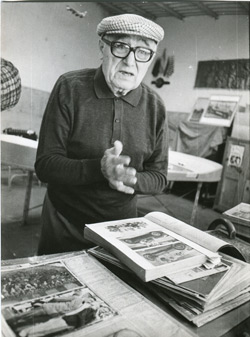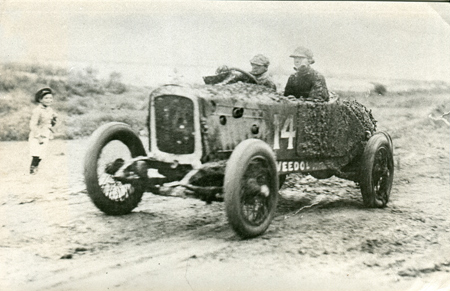

By ENRIQUE SÁNCHEZ ORTEGA
He made the classic school of motoring pioneers: bicycles, motorcycles and then the adventure of unruly four-wheelers. He lived with all the legendary characters that made, like him, our sports motorsport. He won his first Grand Prix in 1927 and repeated the triumph in 1930. He was twice in the Indianapolis 500, set a world speed record in motorcycles and today, more than half a century later, he remembers each of those moments he lived so intensely
"Give it back to the handle, Negra!" the half-tormented fioca shouted from the truck.
And La Negra, obsequious, was once again spinning the string and the nasty victrola, played by the tone that gave him the revolutions that were always much more than 78 per minute, grumbling with the weeping and weary background of violins and bandoneons very syncopated ...
Today your name is right Chaaan-chán! Thus ended the last verse and, with the click of the barb hitting the label, the voice of Rosita Quiroga was muted on the National record with lyrics and music by Julio Vivas and Gradito. Everything was loaded with admiration towards the winner of the National Grand Prize of 1927. To the owner of the circuits of dust and mud and shoulders, to the prototype of the popular hero, self-made man of that time. From those days of voiturettes, coperas and much "Armenonville" for the children well. Those packets that surrounded those things Juan Antonio Gaudino, a former cyclist and former motorcyclist who had immersed himself in the fashion or passion of motorsport.
Because Tunin Gaudino was not like them. He was only an immigrant born in 1894 in Turin and transplanted three years later to this adventure that was the exile to the South American pampas. A "tano" immigrates ready for those innate things to the sport, which began with the two wheels pedaled. From there he says that he learned all the tricks and tricks that years later he was going to apply in motorcycle racing and later in motorsport. A kid who started running in 1909 (no less!), When Dartiguelongue hired him to be a team assistant with an Alcyon. A bombastic title that was equivalent to saying "volteador", the one in charge of turning over the rivals of the team.
Sixty-five years after his racing debut, Gaudino is still alive and kicking. Precisely because of this: making a note about your activity is impossible. It would be necessary to make a Bible. So many years are millions of stories and anecdotes, that as the years go by it's hard to bring them back from the beyond for those of us who did not live those days.
But he continued. "In 1910-1911 he was completely dedicated to bicycles.
"In 1918, more or less, I went from bicycles to motorcycles. I ran with B.S.A., Excelsior for a long time and Harley Davidson, the brand I most wanted and with which I achieved a world record. On January 20, 1924, at the circuit of Morón, I got the world speed mark after walking twelve hours and reducing that weight by five and a half kilos. But that did not hurt me because I had become accustomed to rigorous training since the days I was riding a bicycle. Normally I got up at three thirty in the morning and at four I went out on the road to pedal. I was going to Luján or to La Plata breathing the pure air of dawn, that way it oxygenated me and I did not need to resort to the "pichicata" not to get tired like the runners of today. "
In 1922, following the logical evolutionary cycle happened to the cars. With the great school and experience of bicycles and motorcycles on the back. He started with a Gardner in a race from Buenos Aires to Rosario and had the advertising of private cigarettes painted, for which he was given 15,000 pesos of those, a lot of silver. Later he was a man of the Hupmobile brand and later, definitely, of Chrysler. Although he once tried some mischief with Peugeot or with Fiat.
In 1927 he won his first Grand Prix. The test of fire and access to the fame of the heroic motorsport of the times when Frank Sinatra was a bambino ...
"I went out to travel the route and to train myself traveling behind the trucks, in the middle of the earth cloud. In that way I learned to run blind. To "record" the road without seeing it. With the seat I felt when the curves were approaching, and if I could I would look at the telephone poles to hit the swerve of the turn. I trained a whole month before the races. Then I applied what I had learned with bikes and bicycles, such as taking advantage of the confusion of the starts and sticking to the fences more than 500 meters to advance to the peloton.
"Everyone wanted to get ahead at that time. But I preferred to leave in the middle or behind. Because I had some driving secrets that I did not even tell my brother. Long distance races always took place in Morón, and I always had to be first when arriving at Pergamino. But once it was not given to me. When I got to Pergamino, I had him at Zatuszek 100 meters in front of me. From there we turned to San Nicolás and the Mercedes left me about 1 kilometer and a half. But when we were crossing the Arroyo Seco, I could put it on par. I snuck into his cloud of land and started to put the trunk. When I had it on par I tightened the clutch (because I had rest) and accelerated it in a vacuum. I could pass it but I did not want to. As his Mercedes had a compressor that could not be connected all the time if not in a very short time, my intention was to demand it in such a way that it would connect the compressor and burst everything ...
"I put it on par and El Alemán connected the" pig ". It took me about fifty meters and when I pulled the compressor I reached it again and I took it half a car ahead.
"He arrived in Rosario with two fused rods!
"In another Grand Prix I wanted to do the same but already El Aleman had revived. The bad thing about Zatuszek was that he was half out of control with the car and could kill you. "
In 1932 he went to Indianapolis alone, with a Chrysler.
"To go I had to pawn the 54 gold medals I had won until then because the mayor of Buenos Aires did not allow a festival to be held on the Hurricane court to raise funds. Then my wife was wrong with the deadline to withdraw them and I lost all my prizes.
"In the course of the race I had an accident when one of the supply tanks caught fire and I burned my leg.
"The following year we returned, although my wife objected because I was very afraid after what had happened the previous year. So I told Riganti to accompany me as the official driver of the car and I went as a substitute, or second driver. Anyway, I stuck 64 laps to the circuit during qualifying and finished 14th in the race.
"I was very close to all the ranchers. From Luro, from Duggan, from Macoco ... And it was all because one day one of them, a Rosario who had a Hispano-Suiza, came to see me because he could never win any bit of what was done from the Monument of the Spaniards to Dorrego, along Alvear Avenue. They passed in front of the Luro house, which is where the North American embassy is now. Sometimes Alvear came to bite and there was also Federico Lacroze, who had a "Hispanito" career. Then I quoted the rosarino (I do not remember the name) so we were behind the filters of Sanitary Works, where there was a piece of road paved under. There I taught him some of my secrets ... how to go in second or first and comb the clutch so that the engine, spinning in a vacuum, would spin around. Thus it was that in the next bite the Hispano del rosarino arrived first at Dorrego. Until 'the guindado of the Uruguayans'. And it was called 'el guindado' because these Uruguayans who were two big brothers brought from Uruguay a cherry with peppermint in demijohns; It was a corralón where all the horsemen, like them, went to eat buseca and minestrón.
"After that they all came looking for me and took me to the 'Armenonville'. They asked for champagne (many bottles of Pomery, which cost two pesos fifty at that time). They pushed four tables together and sat me on top. The cabaret girls did not understand anything, and all of them asked me to teach them my secrets. They were all very good and they loved me very much, even though I was very humble, I had a motorcycle workshop. "
Today he wants to teach everyone how to drive. Reveal their secrets, rebelling against the way they handle "lying down" nowadays, or denying the wide gums, that "so anyone handles ..."
"I cry every time I find out that a young boy is killed in a car accident. But I really cry, with tears. Because if everyone listened to me they could live 80 years without accidents. "
ARTICLES OF VOLUME II
the story will pass
and recorded you will take
your feats of a man
written without blur
so that all Argentine
know that it was Gaudino
man of condition.


 Anasagasti fue el primero
Anasagasti fue el primero
 Empecé a correr allá por 1908
Empecé a correr allá por 1908
 Mercedes Benz SSK
Mercedes Benz SSK
 Vauxhall 30-98 Tipo OE 1924
Vauxhall 30-98 Tipo OE 1924
| Contact: (+549) 11 4027 8262 / sancho1978@gmail.com |
| Home | Volume I | Volume II | Volume III | News | Photo Gallery | Contact |